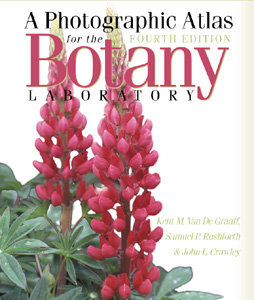Course examinations often include essays. The final examination is an essay. An essay must be submitted explaining the plant contributed to the ethnobotanical garden. Essays are marked using the following rubric.
| Syntax |
|---|
| 5 | No errors of grammar or word order. |
| 4 | Some errors of grammar or word order but communication not impaired. |
| 3 | Errors of grammar or word order fairly frequent; occasional re-reading necessary for full comprehension. |
| 2 | Errors of grammar or word order frequent; efforts of interpretation sometimes required on reader's part. |
| 1 | Errors of grammar or word order very frequent; reader often has to rely on own interpretation. |
| 0 | Errors of grammar or word order so severe as to make comprehension virtually impossible. |
| Vocabulary |
|---|
| 5 | Appropriate terms used consistently, clear command of vocabulary, no misspelled words. |
| 4 | Occasionally uses inappropriate terms or relies on circumlocution; expression of ideas not impaired; or a few misspelled words. |
| 3 | Uses wrong or inappropriate words fairly frequently; expression of ideas may be limited because of inadequate vocabulary. |
| 2 | Limited vocabulary and frequent errors clearly hinder expression of ideas. |
| 1 | Vocabulary so limited and so frequently misused that reader must often rely on own interpretation. |
| 0 | Vocabulary limitations so extreme as to make comprehension virtually impossible. |
| Organization |
|---|
| 5 | Material exceptionally well organized and connected including introduction, body, and conclusion structure. |
| 4 | Material well organized; structure could occasionally be clearer but communication not impaired. |
| 3 | Some lack of organization; re-reading required for clarification of ideas. Missing structures such as an introduction or conclusion. |
| 2 | Little or no attempt at connectivity, though reader can deduce some organization. Missing two or more structures such as the introduction and conclusion. |
| 1 | Individual ideas may be clear, but very difficult to deduce connection between them.
|
| 0 | Lack of organization so severe that communication is seriously impaired. |
| Cohesion |
|---|
| 5 | Consistent choices in cohesive structures. Ideas flow logically within the body and reflect the introduction. Essay remains on topic. Connector words assist the reader. |
| 4 | Occasional lack of consistency in choice of cohesive structures and vocabulary but overall ease of communication not impaired. |
| 3 | 'Patchy', with some cohesive structures or vocabulary items noticeably inappropriate to general style. Ideas tend to be disconnected from each other. Reads more like an outline than a coherent essay. |
| 2 | Cohesive structures or vocabulary items sometimes not only inappropriate but also misused; little sense of ease of communication. |
| 1 | Communication often impaired by completely inappropriate or misused cohesive structures or vocabulary items. |
| 0 | A 'hodgepodge' of half-learned misused cohesive structures and vocabulary items rendering communication almost impossible. |
| Content |
|---|
| 10 | Fully complete and thorough answer to the task set. Addresses the areas required in the essay description. Content coverage is excellent. |
| 8 | Relevant and adequate answer to the task set with only a single gap or missing task item. |
| 6 | For the most part answers the task set, though there may be some gaps or redundant information. |
| 4 | Answer of limited relevance to the task set. Possibly major gaps in treatment of topic and/or pointless repetition. |
| 2 | The answer bears almost no relation to the task set. Inadequate answer. |
| 0 | No evidence of assigned task. |
| Printed format | Handwritten penmanship |
|---|
| 5 | Fully correct format: 12 point serif font, one inch margins, block paragraphs. |
5 | Exemplary near perfect penmanship, letters on the line, correctly formed letters, even and appropriate spacing between letters and words, legible. |
| 4 | Some minor errors in format such as font size or serif. |
4 | A few inconsistencies in spacing and letter formation, penmanship is neat. |
| 3 | Frequent errors in format. |
3 | Frequent errors in spacing or letter formation, some difficulties in reading due to legibility. |
| 2 | Substantive, frequent errors in format, such as text running off the page thus rendering the essay partially incoherent. |
2 | Substantive, frequent errors in spacing, letter formation. Difficult to read, penmanship problematic but still decipherable. |
| 1 | Formatting errors so fundamental and pervasive as to render the essay unreadable and incomprehensible. |
1 | Penmanship errors so fundamental and pervasive as to render the essay almost unreadable and incomprehensible. |
| 0 | Blank sheet of paper. |
0 | Illegible scrawl. |
 Plants, people, and culture: The Science of Ethnobotany. ©2005 Balick, Michael J., and Cox, Paul Alan. ISBN 0615129536. Distributed by the American Botanical Council, P.O. Box 144345, Austin, Texas, 78714-4345, Herbalgram.org, Phone: 512-926-4900
Plants, people, and culture: The Science of Ethnobotany. ©2005 Balick, Michael J., and Cox, Paul Alan. ISBN 0615129536. Distributed by the American Botanical Council, P.O. Box 144345, Austin, Texas, 78714-4345, Herbalgram.org, Phone: 512-926-4900